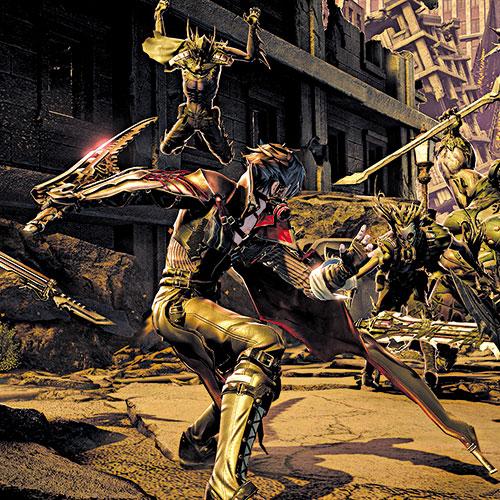Adding flexibility to ‘Dark Souls’-style play

Platform: PS4, Xbox One, PC
Genre: Action role-playing
Publisher: Bandai Namco Entertainment
Developer: Bandai Namco Studio
Rating: M, for mature
By Gieson Cacho // The Mercury News (TNS)
Dark Souls has grown popular enough that it has spawned its own subgenre. Several games ape its slow-paced combat systems and rigid progression system, but few bring new ideas into play. They tend to focus on mimicking its mechanics and difficulty.
Not many try to tweak its ideas or broaden them out beyond the “Git Gud” crowd, but Code Vein is different. Producer Keita Iizuka saw a wasted opportunity in the inflexible systems that force players to make a play style choice and let that dictate how they level up and craft their hero.
If players in Dark Souls want to wield heavy weapons, they have to devote skill points to strength and endurance. If they want to cast spells, they’ll have to put points in intelligence. If players want to try a different style, they’ll have to replay the game with a new build in mind.
Code Vein is novel because it lets players switch between classes seamlessly. The class changes automatically rearrange the stat numbers. The protagonist is special in this postapocaylptic world because the hero can take on several Blood Codes while normal characters only use one. They can change from Fighter, Ranger and Caster initially. Each class changes a player’s stats and that in turn pushes them to equip gear suited for each role.
“We encourage users to experiment. Go through trial and error and try different strategies or combat styles,” said Iizuka. “For some enemies, you want to use Casters or melee attackers, that’s something we want to put an emphasis on.”
Instead of being railroaded into an archetype, players have an opportunity to explore the space, and that’s one of the biggest strengths of Code Vein. In the demo I played, I checked out the robust character creation system and designed a protagonist. I checked out the tutorial introducing the class systems and jumped into the narrative.
In Code Vein, the protagonist wakes up alongside a mysterious girl in white. Both have amnesia. While exploring the ruins of a city, they are captured by other Revenants, and they’re forced to work for them. I was thrown into a mission where I had to harvest blood beads in the underground. Thankfully, I had a partner named Oliver Collins, who marks a big difference between Code Vein and Dark Souls. The former adds an AI partner into the mix.
“It lets you explore and be more aggressive,” Iizuka said. “There’s a difference between the mentality. You feel … braver in challenging the enemies. As compared with Dark Souls, you’re alone. It hinders you to move forward.”
In addition, the partners introduced new strategies and make some classes more viable. With a partner, they can take on more of a support role as a Ranger and let their buddy do the up-close fighting.
The partner AI can also heal players when they’re low on health. Along the campaign, the protagonist will meet different allies, who each have their distinct stats and abilities. Players can’t customize them, but they do add a layer of strategy when deciding which buddy to bring along. Ideally, it’s someone who meshes well with their Blood Code class.
Code Vein emphasizes how important buddies are early on during the first tough battle. Oliver ends up injured and players venture alone for a short time before running into another Revenant who offers his help.
Players can choose to take up their offer or go it alone. Being suspicious, I chose to tackle the room solo, but after dying a few times, I understood that partners are vital to the experience.
This introductory mission also nudges players to explore the Blood Code system. As they explore the underground and unearth more powerful gear, they discover that the equipment called Blood Veils enhance certain attributes. It behooves them to combine the equipment with the right class and switch up the play style.
I went from being a Fighter, in which melee and stamina were important, and turned into a Caster that relied on Ichor (Mana) to use Gifts (spells). Instead of trying to pull off combos with weak and strong attacks, my fighting was more strategic as I peeled off foes from a crowd so that I would be able to take them on one on one.
Because I was a Caster, my armor and health were lower and I had to use Regen, which is the equivalent to the Estus Flask in Dark Souls. It’s a potion that lets players heal. It runs out after three uses, but it can be refilled at Mistles. These are Save Points and equivalent to Dark Souls bonfires. At these resting points, players can also level up and change the different Gifts that complement their Blood Codes.
One interesting note is that certain Gifts can only be used by certain Blood Codes, but if players use the spells often, they can have permanent access to them. They can be used outside of their Blood Code classes.
For those who need more help, players can bring in a human partner via an SOS system. Players can ask for help and an alert will go to others online. Players can decide whether to join up and enjoy a cooperative experience with a three-player party. Iizuka said the process is supposed to be seamless.
Bandai Namco will be doing a network test later in May for the game. Code Vein itself is scheduled for release on the PlayStation 4 and Xbox One later this year.











